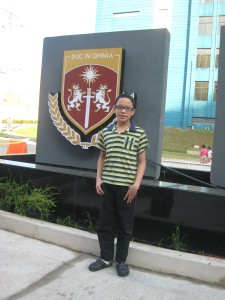When I learned that the top 60 kids would go to Treston International College for training, I was very grateful for being one of those lucky few. I haven’t heard of the school before but some of my friends told me that it was a really good chef school. My mom was ecstatic as well because it was an amazing opportunity.
Starting on the 24th of May this year, my JMC friends and I gathered at PBB House every morning, at around 7 am and rode the ABS-CBN van to Treston.
I was hoping to learn more about different kinds of knives, pans ,knife skills, cooking equipment and ingredients.
When I went into Treston International College, I saw different kinds of rooms. There was a lecture room, a cold room for cooking desserts and a hot room for cooking hot meals. We would move from room to room depending on what we were supposed to do on a certain day.
On our first day, we learned about kitchen safety, hygiene, cooking terminologies, equipments and pantry ingredients. Here are some of the notes I took.
HAZARDS
A hazard is a danger or risk that could come from food, smoking, health and fire. Biological hazard pose a threat to the human health. Chemical hazard contaminates food with chemicals. Physical hazard are dangerous things that could come from metal from canned foods, pieces of bones from chicken and fish. Broken glasses from bottled sauces and spices and ripped plastic that comes from food packaging are examples of physical hazards. Some people get sick from eating ripped plastics unknowingly.
FATTOM
Bacteria grows on food when six conditions are met. The six conditions include Food, Acidity, Time, Temperature, Oxygen and Moisture. The acronym of these six conditions is FATTOM.
 F – Food has protein, calcium, nutrients and a lot more vitamins you could think of. Bacteria grows on rich protein food like meat, milk, eggs and fish.
F – Food has protein, calcium, nutrients and a lot more vitamins you could think of. Bacteria grows on rich protein food like meat, milk, eggs and fish.
A – Acidity means the level of acid in substances such as wine, water or soil.
T – It only takes at least two hours for food to change condition. Food needs to be removed from the “danger zone” by cooling or heating.
T – Bacteria grows within a temperature danger zone (TDZ) , which is between 41 degrees F and 135 degrees F.
O – Oxygen is a colorless gas. Bacteria needs oxygen to grow in food.
M – Bacteria grows when moisture is present.
PERSONAL HYGIENE
Always take a bath before and after you cook. If you’re in a restaurant, always wear clean uniform. Wash your hands before, after and while cooking.
KNIFE SAFETY
Knife safety is really important. If you follow the knife safety tips, you’ll be safe in the kitchen. If you don’t follow these tips, you could hurt yourself.
You shouldn’t leave the knife handle protruding off the table because someone might bump it and it will fall on his or her foot. You shouldn’t walk or run when the knife is pointing in front of you. You might hurt yourself or other people.
KITCHEN SAFETY
No running in the kitchen because you might trip. Don’t use electrical appliances when your hands are wet. You’ll be electrocuted. Be careful when you chop or slice food because you might cut yourself and contaminate the food with blood. Don’t put fire catchable things like kitchen towel, face towels or cook books on the gas stove. Keep chemicals away from food. The chemical might spill on the food.
COOKING TERMINOLOGIES
Moist cooking methods are blanch, poach, braise and steam. Blanch means to boil food on water then finish cooking it on an ice cold water. Poach means to boil food on a small amount of water. Steam means to cook food using the smoke of boiling water. Braise means to fry food lightly then stew it slowly in a closed container.
Dry cooking methods are pan fry, deep fry, roast and grill. Pan fry means to cook food on a small amount of oil. Deep fry means to cook food on a lot of oil and cook until crunchy. Roast means to cook food in an oven. Grill means to cook food on a griller.
(to be continued)
Click on the logo for information on how to donate to my charity :







